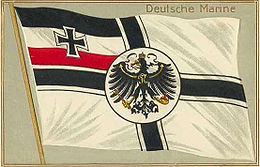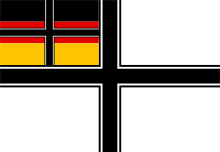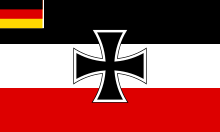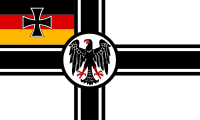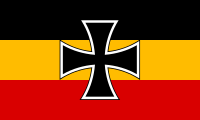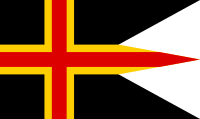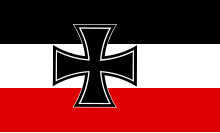Reich war flag
The Imperial War Flag was until 1892 the official war flag of the Imperial Navy , then under the name Reichskriegsflagge the flag of the armed forces of the German Reich to 1921. The part derived versions in the Weimar Republic and the flags in the era of National Socialism were also as reichskriegsflagge designated.
German Order Cross
The use of the Teutonic Cross in flags dates from the time of the Crusades . A black cross on a white background formed the badge of the Knights of the Teutonic Order . As such, this cross bar was adopted in the flag of the North German Confederation as well as in the war flags of the German Empire and the Nazi era. The Bundeswehr still uses it today as a national emblem .
War flag of the Reichsflotte
The Reichsflotte , founded by the Frankfurt National Assembly in the course of the revolution of 1848/49 , used the colors black-red-gold as the naval war flag with the double-headed imperial eagle placed on a golden field in the upper corner . The flag was introduced by an imperial law of November 12, 1848 . After the restoration of the German Confederation , the Reichsflotte was dissolved in 1852 and the black, red and gold war flag was no longer used.
During the introduction of the war flag of the Reichsflotte, the German central authority failed to have the new flag recognized by the sea power Great Britain. This led to an incident in the First German-Danish War on June 4, 1849 . At Heligoland , which was still British at the time, the British fleet shot at a ship of the Reichsflotte that was flying the new war flag and was chasing a Danish ship. The British ships viewed the ship sailing under the new flag of war as a pirate ship. The last time the war flags of the Reichsflotte were brought down on April 11, 1852, were brought to the federal fortress in Mainz on Otto von Bismarck's instructions .
War flag of the North German Confederation
The establishment of the North German Confederation on August 18, 1866 required the design of both a trade flag and a war flag. While a solution was initially found with the black-white-red trade flag on June 22, 1867, the introduction of the war flag was delayed. The Commander-in-Chief of the Navy of the North German Confederation, Adalbert von Prussia, was commissioned with the development and drafts for the new war flag . As early as 1850, Adalbert proved to be the creator of numerous flag designs for the German Union planned by Prussia , which was to form a small federation excluding Austria , as well as for a new naval flag and Gösch for the imperial fleet. Many of these designs were based on the black, red and gold flag of the German Confederation and combined the colors in different ways with an iron cross.
- Proposals for a naval war flag of the Reichsflotte from Prince Adalbert of Prussia
Adalbert later used some of the drafts for the German Union as the basis for the new war flag that was to be developed. Adalbert believed that the colors of the trade flag should definitely be incorporated into the new war flag. The background to this was his conviction that effective protection of the merchant navy by the war fleet is only possible by matching the colors of the respective flags. Both the respect in foreign ports for the merchant fleet and the respect of the north German merchant ships for the war fleet would be guaranteed with a match of the colors.
Adalbert intended to keep the traditional Prussian, white ground cloth and to put a black cross on top of it, which quartered the flag altogether. This black cross should represent an embodiment of the Iron Cross , as it was already contained in the Prussian war flag of 1818. In a letter to the Prussian King Wilhelm I of January 9, 1867, Adalbert wrote:
"So I humbly suggest dividing the flag with the Iron Cross, a symbol that the Navy attaches great importance to."
However, Adalbert was of the opinion that a modeled after the original cross with curved edges on the flag was not acceptable, as other seafaring nations generally used straight crosses on flags:
"There is no slouched cross in any flag and this would therefore be found conspicuously everywhere abroad."
Countless drafts and sketches by Adalbert show that he tried to adhere to the requirements of the king, who insisted on strict adherence to Prussian symbolism. They were rediscovered in the 1960s. From the large number of designs, a model was finally shortlisted that showed both the iron cross shaped as a bar cross, the federal colors, and the Prussian eagle. It was Wilhelm I who ultimately determined the final design of the war flag. Since he insisted on showing the Iron Cross in its original form on the flag, the Prussian eagle was placed on a white, circular field at the intersection of the cross, while a version of the Iron Cross based on the original was placed on the imperial colors in the upper left Corner was placed. With the highest cabinet order of July 4, 1867, this pattern was finally designated as the war flag of the North German Confederation. The official introduction of the new war flag took place on October 1, 1867 when the old Prussian flags were brought down on all warships, shipyards and depots. An eyewitness described the hoisting of the new war flag:
“The Prussian flag was hoisted shortly before 9 o'clock after the crew had gathered in parade gear and was taken down after the commandant had spoken about the importance of the incident; then the German war flag, greeted with three "cheers" and 21 shots of honor, rose from the gaff with the presentation of the marines detachment and the marching of the drum: a historical moment! "
The German Imperium



After the establishment of the German Empire in 1871, the symbols of the North German Confederation were adopted. Since Prussia continued to be the leading political force in the newly created state, the flag of war was also carried on. The Prussian eagle was depicted unchanged and was never replaced by the imperial eagle. Was the name of the flag from the year 1871 still imperial war flag , as was done from the year 1892 a general renamed Reichskriegsflagge . In the years 1892 and 1903, minor modifications were made, when the shape of the eagle was first changed, and in 1903 the width of the black stripes and the border of the central pane were changed. However, old versions of the war flag were used until they were "used up", with precise dates for the final implementation. An order from the Reichsmarineamt allowed the use of the first version of the war flag until April 1, 1896 and the second version until April 1, 1907. The change of the Prussian eagle in 1892 had purely "fashionable" reasons, while the change in width of the black stripes took place due to the fact that the Reich War Flag had a certain resemblance to the British war flag (" White Ensign ") at a great distance . This manifested itself in an incident with a Russian warship to salute accidentally British, instead of the German war flag hoisted, which amounted at that time an insult. Up to 1903, the stripes corresponded to a seventh of the flag height. After that time, they were expanded to a quarter of the flag height.
Initially only intended for the navy at sea, the war flag was also used by members of the government of the federal states from March 2, 1886 .
During the First World War , the Reich war flag was part of numerous propaganda images . Probably the best-known representation of this kind is the painting “The Last Man” by the Berlin marine painter Hans Bohrdt , which shows a scene from the naval battle on the Falkland Islands on December 8, 1914.
After the founding of the republic in 1918 , the old war flag was de facto still used as a war flag at sea until December 31, 1921. In addition, it was used in the Weimar Republic to demonstrate anti-republican political goals and, together with the old Reich flag, was a mark of politically "right-wing" parties and organizations, especially the warrior associations and veterans' associations, which took up the tradition of the old army with a negative attitude associated with the republican order and avoided its symbols. In the years between 1926 and 1944, the last version of the abolished imperial war flag was hoisted on the ships of the Kriegsmarine every May 31st to commemorate the Battle of the Skagerrak in 1916.
Weimar Republic
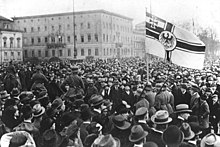

The establishment of the German Republic in 1919 made it necessary to change the war flag, as it was equipped with symbols of the monarchy. With the decree on the flag of the Reich President, the flag of the Reichswehr Minister and the new Reich war flag together with Gösch of September 27, 1919, a new Reich war flag was ordered. This should be based on the imperial model, but with the following differences: Instead of the black, white and red upper corner, the new imperial colors black, red and gold were to be set, and the old Prussian eagle was to be replaced by the new republican one. This decree was published on November 1, 1919. Although models of this flag have been made, it has never been used.
- Drafts for a 1919/20 Reich war flag

 ? Accepted but not used Reich war flag from 1919 with a legally not yet defined Reich eagle based on a design by Emil Doepler
? Accepted but not used Reich war flag from 1919 with a legally not yet defined Reich eagle based on a design by Emil Doepler

 ? Draft of the Reich war flag from September 14, 1920
? Draft of the Reich war flag from September 14, 1920

 ? Draft of the Reich war flag from October 19, 1920
? Draft of the Reich war flag from October 19, 1920
Since President Friedrich Ebert did not give a specific date for the introduction of this flag, the head of the Admiralty, Adolf von Trotha , was able to include the sentence " Until then, the previous war flag and jacks " should be included in the implementing provisions of the law . Thus, in practice, the Imperial War Flag from 1903 continued to be used, which was not finally abolished until January 1, 1922. In a daily order from the Reichsmarine dated January 1, 1922, it said: “ What we feel when this flag sinks, we lock up in our hearts. "
The continued use of the old war flag was a concession by the imperial government to conservative forces in the imperial navy who had no interest in introducing new republican symbols. The Reichswehr leadership also pointed out that the war flag should usually wear the same colors as the trade flag. For the latter, the old colors were initially used for reasons of international recognition; Due to a compromise, a black, white and red basic cloth with a black, red and gold corner was adopted in July 1919. Another reason for the continued use of the old war flag was the unclear shape of the new imperial eagle , which at that time had not yet been determined and had long been controversial.
On September 14, 1920, a draft regulation on German flags was sent to all Reich ministries. This contained the proposals for the new flags on a flag board, including the new Reich War flag. The shape of the imperial eagle on it came from the artist Karl Schmidt-Rottluff . However, this draft met with strong general opposition.
In a draft of an ordinance on German flags that was passed in the cabinet on October 19, 1920, a modified form of the Reich War flag was determined without the new, controversial Reich eagle and with different dimensions: The Reich War flag has a black, rimmed flag on a white background Cross that extends over the entire field and whose right crossbar is slightly longer than the left. In the upper inner corner are the imperial colors […], on it the iron cross, height to length as 2: 3. This draft was never put into practice either.
On November 16, 1920, an agreement was finally reached on a complete redesign of the war flag, which now resembles the trade flag and is only to be distinguished from it by the iron cross. This was suggested by Reichswehr Minister Otto Geßler : The Reich war flag like the merchant flag, in the middle of the flag a black, white-rimmed cross in the shape of the Iron Cross, in the black and red horizontal stripes each overlapping up to a third. Ratio of the height to the length of the flag cloth as 3 to 5. With the ordinance on German flags of April 11, 1921 , the new Reich war flag was officially introduced; In its basic structure it no longer had any resemblance to the imperial models, although apart from the black, red and gold in the corner, it was similar to the warship gösch used until 1918 . As early as August 11, 1921, the new war flag was hoisted ashore on their buildings by the military service authorities. With the final abolition of the imperial model from January 1, 1922, it was also used as a flag at sea.
The finally realized design of the war flag - like that of the trade flag of 1919 - should enable a compromise in the flag dispute. By combining or “merging” the “republican” and “imperial” colors in a common flag, an attempt was made to find a balance between the political camps that was acceptable to all sides. The flag was used until the Nazis came to power in 1933.
Proposals for a national and war flag in 1926
In the 1920s, the "flag question" was hotly debated. While the social democratic forces favored black, red and gold, the right-wing conservative parties and especially the National Socialists were strictly against these colors and preferred the old imperial colors black, white and red . In the course of this, numerous important heraldists , such as Ottfried Neubecker or Manfred Eimer , dealt with new concepts for creating a national and war flag that was accepted by a large majority. In 1926 in particular, they approached the public with various proposals. The stripe flag designed by Ottfried Neubecker in the colors black-gold-red was of particular “elegance” in that, on the one hand, the “republican colors” were heraldically correct and, on the other hand, the sequence of the “black, white, red” was adhered to has been.
- Proposals for a 1926 Reich War Flag

 ? Suggestion by Neubecker and Wolf
? Suggestion by Neubecker and Wolf

 ? Suggestion from Manfred Eimer
? Suggestion from Manfred Eimer

 ? Suggestion from an unknown author, presumably Neubecker
? Suggestion from an unknown author, presumably Neubecker
time of the nationalsocialism

The National Socialists removed the black, red and gold of the republic and again used exclusively the colors of the empire. By ordinance of the Reich President of March 14, 1933, the black, red and gold colors from the Obereck were dropped, so that essentially the previous war flag was continued. However, the Iron Cross was slightly modified and moved to the bar.
After the death of Reich President Paul von Hindenburg on September 15, 1935, the swastika flag was designated as the only valid national flag for the German Reich. In the course of this, a new war flag was introduced on November 7, 1935, the design of which was based on the imperial war flag. The design for the new flag apparently came from Adolf Hitler himself. On the red primer of the Nazi swastika flag with the white circular area, the white contrasting black Georgskreuz - derived from the German Order Cross - was attached in such a way that the swastika came from the center moved towards the mast. The Iron Cross can be seen in the upper corner of the mast, on the left in a regular plan view . This indicated continuity with the flag versions used prior to 1919.
The new Reich war flag was hoisted for the first time at the headquarters of the Wehrmacht on Bendlerstrasse in Berlin . Probably in December 1937 slight modifications were made to the design, whereby the dimensions and the course of the black stripes were changed. Since the Reich war flags were printed, the reverse of the flag showed a mirror-inverted swastika. At the beginning of the war , there were also war flags with a specially sewn swastika on the back, which, as on the front of the flag, was shown pointing to the right. To do this, a second war flag of the same size had to be cut up. This process was banned in the last years of the war due to a shortage of materials.
The Reichskriegsflagge was used on ships of the Kriegsmarine as well as on aircraft on the ground. It also blew on all Wehrmacht buildings. Originally it was hoisted daily in barracks occupied by units of the Wehrmacht. The raising and lowering took place in a flag parade carried out by the "First Officer", in which the guard and a member of the Wehrmacht musicians took part. On festive occasions, the "escort unit" was significantly expanded. In later years, in the absence of the soldiers stationed in the barracks, the “First Officer” decided whether and in what form a flag parade should take place. In the course of the war, the Reichskriegsflagge was used for various other purposes, for example to cover the coffins of fallen soldiers. It was also used, for example, to decorate speaker's desks and as a kind of tablecloth in court cases .
By an order of the High Command of the Wehrmacht of February 28, 1944, which came into force on April 20, 1944, an amendment to the swearing-in regulations in the troops was ordered: "All soldiers of the Army and the Air Force are, as in the Navy, on the Swearing in the Reich war flag. "
As a result, new recruits were no longer sworn in to their troop standards as before , but their own weapon and the presence of the imperial war flag were sufficient.
A further expansion of the use of the Reich war flag took place with an order given by Adolf Hitler on August 28, 1944, according to which only the Reich war flag was to be used instead of the flags and standards of the individual troop units that had been used up until then: instead of the troop flags and standards, the Reich war flag. This order was published on September 16, 1944. The flags and standards used before were brought to museums in Berlin, Dresden, Munich and Vienna. This arrangement was supposed to avoid the capture of the flags by enemy troops. Another explanation could be Hitler's dwindling trust in the Wehrmacht under the impact of the July 20, 1944 assassination attempt .
On May 10, 1945, the Reich war flag was brought down for the last time at 12 noon. This happened on the express orders of the British armed forces as part of the capture of the last Reich government in Flensburg - Mürwik , headed by Grand Admiral Karl Dönitz .
Legal situation since 1945
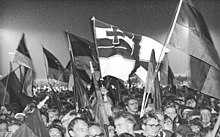
In Germany , the distribution and display of the war flag of the Third Reich with a swastika is punishable under § 86 and § 86a StGB . In Austria the public show falls of such flags under the Offenses ban , insofar as it can be construed as a form of Nazi activity.
The flag of the empire is generally allowed, as are other symbols of the empire. However, it was already used as a symbol of identification by right-wing extremist parties and organizations during the Weimar Republic. So chose z. B. the paramilitary " Bund Reichskriegsflagge " according to its name, this flag is their identification mark. The political leadership of this league in 1923 was with Adolf Hitler. Because of its frequent use by extremists, the imperial war flag is often associated with far-right groups these days.
The showing of versions of the war flag without a swastika in public is possible and does not have to be prevented by the authorities. The flags can, however, be seized by the police if public safety and order appear to be endangered .
In the federal state of Bremen , there has been a decree by the interior authorities (addressed to the police) since September 14, 2020 , according to which the display of the war flags of the North German Confederation and the German Reich, as well as, if there is a concrete provocation effect, the black-white-red flag of the German Reich from 1892 onwards “should regularly represent a lasting impairment of the requirements for an orderly civic coexistence and thus a danger to public order”, which is why “showing or using these flags in public on the basis of the Bremen Police Act (BremPolG ) is to be prevented within the scope of exercising due discretion and the flags are to be secured. "; Violations are threatened with fines of up to 1000 euros. A requirement of the City of Bremerhaven to hold a meeting based on this was deemed unlawful by the administrative court of the Free Hanseatic City of Bremen on October 15, 2020. The complaint of the city of Bremerhaven against this was rejected by the Higher Administrative Court (OVG) Bremen with a decision of October 23, 2020, because there is no intimidating effect to simply showing the flag. In the resolution, the OVG pointed out that the intentional display of the imperial (war) flags did not constitute a direct violation of public security or public order and could therefore not justify a ban on assemblies.
In the Free State of Bavaria , the showing of the Reich war flag should be banned in the near future in 2020. Other federal states have meanwhile also spoken out in favor of a ban on showing in public spaces .
The interior ministers of federal and countries reached on June 13, 2021 agreement with respect to a pattern of adoption against the showing of Empire (war) flags in public. According to this, showing a Reich war flag is to be considered a danger to public order under certain circumstances . The model decree still has to be implemented by the federal states.
See also
literature
- Brian Leigh Davis: Flags and Standards of the Third Reich . Macdonald & Jane's, London 1975, ISBN 0-356-04879-9 .
- Jörg-Michael Hormann, Dominik Plaschke: German flags. History, tradition, use . Edition Maritim, Hamburg 2006, ISBN 3-89225-555-5 .
- Jörg M. Karaschewski : The history of the imperial war flags . 2017, ISBN 978-3-7448-6832-7 .
- Ottfried Neubecker: Proposals for All-German Flags, 1848-1850: Hitherto Unknown Designs Prepared by Prince Adalbert of Prussia . In: The Flag Bulletin . No. 10 , 1972.
- High Command of the Navy (Ed.): Flag book . Berlin 1939 (M.Dv.Nr. 377).
Web links
- Flags of the World: War Ensign 1938-1945 (English)
- documentarchiv.de: Ordinance on the Reich War Flag ... from 1935
- Prohibitive measures. Symbols and marks. Federal Office for the Protection of the Constitution, accessed on June 14, 2021 .
Individual evidence
- ↑ Dreyhaupt / Martin: German National Flags Part I: The Holy Roman Empire of the German Nation. In: Deutsche Gesellschaft für Flaggenkunde Der Flaggenkurier No. 7/8; December 1998.
- ↑ Flags of the World : Prince Adalbert's 1849 Proposals (Germany) (Engl.)
- ↑ Jörg-Michael Hormann , Dominik Plaschke: German flags. History, tradition, use. Hamburg 2006, ISBN 3-89225-555-5 , pp. 65f.
- ^ Jörg-Michael Hormann, Dominik Plaschke: German flags. History, tradition, use. Hamburg 2006, ISBN 3-89225-555-5 , p. 66.
- ^ Ottfried Neubecker: All-German flag plans. Depicted according to the previously unknown designs by Prince Adalbert of Prussia. 1848-1850. In: Deutsches Schiffahrtsarchiv 2, 1978 (= writings of the German Shipping Museum, Volume 9) pp. 207–213.
- ^ Jörg-Michael Hormann, Dominik Plaschke: German flags. History, tradition, use. Hamburg 2006, ISBN 3-89225-555-5 , p. 67.
- ^ Jörg M. Karaschewski: Flags in the German Empire. Norderstedt 2008. pp. 20f. ISBN 978-3-8370-1966-7
- ↑ The highest order regarding the Reich War Flag of December 19, 1892 and announcement of December 28, 1892
- ^ Supreme Order on the Reich War Flag of September 26, 1903 and announcement of October 2, 1903
- ^ Jörg M. Karaschewski: Flags in the German Empire. Norderstedt 2008. pp. 21f. ISBN 978-3-8370-1966-7
- ↑ The highest order to fly the war flag of March 2, 1886.
- ↑ germanhistorydocs.ghi-dc.org: "The Last Man"
- ↑ Marine Ordinance Sheet No. 34, 1919, p. 463.
- ↑ Federal Archives : Files of the Reich Chancellery, 1919
- ↑ Der Spiegel : A flag that nobody wanted.
- ↑ Quoted from: Veit Valentin, Ottfried Neubecker: Die Deutschen Farben. With a foreword by Reichskunstwart Dr. Edwin Redslob. Verlag von Quelle & Meyer, Leipzig 1928.
- ^ Federal Archives: Cabinet meeting on June 1, 1920
- ↑ Federal Archives: Files of the Reich Chancellery, 1920
- ↑ Federal Archives: Files of the Reich Chancellery, 1920
- ↑ Federal Archives: Files of the Reich Chancellery from November 16, 1920
- ↑ Reichs-Gesetzblatt 1921, pp. 483–485.
- ^ Federal Archives: Cabinet meeting on August 3, 1921
- ↑ Flags of the World: Flag proposals from 1926 (English)
- ↑ Flags of the World: Ottfried Neubecker's flag designs. (English)
- ↑ Harald Fock: Z-before! International development and war missions of destroyers and torpedo boats Vol. 1. 1914 to 1939. Koehlers Verlagsgesellschaft, Hamburg 2001. ISBN 3-7822-0762-9 , p. 91.
- ^ Documentarchiv.de: Ordinance on the emblems of the Wehrmacht.
- ↑ Albert Speer : Memories. Ullstein Taschenbuchverlag, Berlin 2005. ISBN 3-548-36732-1 .
- ↑ documentarchiv.de Ordinance on the Reich War Flag….
- ^ Jörg-Michael Hormann, Dominik Plaschke: German flags. History, tradition, use. Hamburg 2006. ISBN 3-89225-555-5 , p. 145.
- ↑ Army Ordinance Sheet. 16th edition, part B, sheet 7, March 27, 1944.
- ^ Letter from the Chief of Army Armaments and Commander of the Replacement Army from September 16, 1944.
- ^ Brian L. Davis, Malcolm McGregor: Flags of the Third Reich. Vol. 1 Wehrmacht. In: Men-at-arms series. 270, Osprey / Reed International Books, London 1994. ISBN 1-85532-446-6 , p. 17.
- ^ Walter Lüdde-Neurath: Dönitz government - the last days of the Third Reich. Verlag S. Bublies, Schnellbach, 1999. p. 109. ISBN 3-8061-1020-4
- ↑ Historical Lexicon of Bavaria : Bund Reichskriegsflagge.
- ^ Protection of the Constitution Brandenburg : Overview of the signs and symbols forbidden in Brandenburg. (PDF file; 524 kB)
- ↑ The statements of the Federal Office for the Protection of the Constitution read: “The use of the 'Reich War Flag' does not meet an offense of the Criminal Code or the law on administrative offenses. Nevertheless, according to general police and regulatory law, the 'Reich War Flag' can be ensured if this is the necessary, appropriate and proportionate measure in specific individual cases to ward off specific dangers to public safety and order. This is z. B. the case when the flag is the focal point of a specific imminent danger and this can be remedied. "
- ↑ Decree on dealing with the public display of Reich war flags. The Senator for the Interior, Free Hanseatic City of Bremen, September 14, 2020, accessed on June 14, 2021 .
- ↑ It is forbidden to show Reichskriegsfahnen and Reichsfahnen senatspressestelle.bremen.de, accessed on September 19, 2020
- ^ Reichsflaggen banned in public - fine of 1000 euros , deutschlandfunk.de, published and accessed on September 18, 2020.
- ↑ Bremen forbids imperial flags in public. In: Zeit Online. September 18, 2020, accessed September 19, 2020 .
- ↑ Administrative Court of the Free Hanseatic City of Bremen, decision of October 15, 2020, file number: 5 V 2212/20.
- ↑ a b OVG Bremen, decision of October 23, 2020, Az. 1 B 331/20 , quote: “For this it is not enough that the imperial (war) flag is now used by right-wing extremists as a distinguishing mark and is now also understood as such . There would have to be additional accompanying circumstances in order to assume the intimidating effect demanded by the Federal Constitutional Court. "
- ↑ Söder wants to ban the Reich war flag in Bavaria. In: The world. September 26, 2020, accessed September 26, 2020 .
- ↑ Will there be a ban on Imperial War flags? In: Sunday paper. October 4, 2020, accessed October 9, 2020 .
- ↑ a b c Interior Minister Strobl - Decree against Reich flags stands. Second German Television (ZDF), June 13, 2021, accessed on June 13, 2021 .
- ^ A b c Christian Rath: Reich war flags and right-wing extremists: No general ban. taz Verlags u. Vertriebs GmbH, June 13, 2021, accessed on June 14, 2021 .
